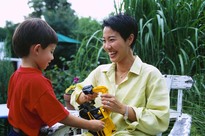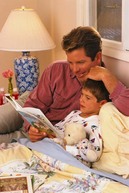 When my son was a youngster, he wanted to play baseball. Of course, I helped him prepare and he tried out for Little League and made the team. Come game time, he occasionally struck out. At first, he would stomp his feet, throw the bat, and cry. The coach rightfully gave him a talking to, as did I later after the game. It also gave me motivation to join an adult baseball team. If, at times, he saw me handle striking out, then that might help him handle the frustration better as well. How are you as a role model for your children? Some parents fall back on the old saying, “Do as I say, not as I do.” Wow! Not a healthy perspective. Wouldn’t that promote hypocrisy and the notion of getting away with as much as you can? How about this one? “Out of sight, out of mind.” Are you one way with company and another way at home? How are you as a role model for your children? You get no time off as a role model. Your children are aware of who you are, what you do, how you talk 24/7. Certainly when they are toddlers, you are their world. As they get older and wiser, you are still their world. They’re just not going to tell you, and they are looking to find fault and exceptions. Proverbs 22:6 tell us to “raise your children in the ways of the Lord so that, when they grow old, He will not depart from them.” If our role model is the Lord, and we demonstrate His judgment, compassion, and mercy in raising our children, then we give our children every opportunity to succeed in life. We were at a theme park when our kids were 13 and 10. Where got lunch was very busy. The hot dog man gave us our order through the window and turned to get the next order. “Excuse me, but did you want me to pay for this? I said. He sputtered, “Oh yeah,” and told me the amount. I paid him. As we left, my son piped up, “Dude, why did you do that? We could have just walked away and had a free lunch.” He was exactly right. However, seizing the teachable moment, I told him, “but, son, that would have been wrong, cheating, and that’s not who we are.” How are you as a role model for your children?
0 Comments
 Pre-teen Amy comes home from school and bursts through the kitchen door. “The other girls are being mean to me. I hate them,” she cries as she melts into her mama’s arms. You hug and console her, using your best active listening to help her through her hurt feelings. Amy feels better but concludes, “I’m never going back to school.” Your continued active listening brings her emotional fever down. She soon feels better and loses interest in talking any further. Tweenager is the term for children who are no longer children but not yet teenagers. Tweenage drama is universal. You did your best in helping Amy with her immediate upset, but there’s more talking to be done. Later that night, during the bedtime routine, you speak up. “Sweetheart, I’m so sorry those mean girls got to you today. Let’s pray that tomorrow will be better.” Afterward, you lead with, “You know, Amy, I have some thoughts. Do you want to hear them?” Whatever your child’s age, asking permission to talk to them perks up their ears and almost always leads to a yes answer. Generally, drama comes from two sources, either worry or sadness. Worry starts with the question, “What if…?” What if they stay mean to me? What if I can’t get over it? And so forth. Sadness usually starts with the statement, “If only…” If only I had walked down the clear hallway. If only Kathy would have stood up to them for me. Being a mindful parent involves helping your child understand their feelings in the moment by active listening. Then, help them stay in the moment as they interact with you and others. Consider my stretched out arms to be the ends of a straight time line that stretches from way in the past, on my left, through the present, to way into the future on my right. Take the midpoint and sweep your left hand out. Sadness is regretting the past. Take the midpoint and sweep your right hand out. Worry is fearing what lies in the future. By bringing both of your hands from the outstretched ends together at the midpoint, you are being mindful and staying in the moment. Mom’s explanation to her daughter Amy was a profound teachable moment that helped Amy take care of her own problems, and not let stuff get to her, by being mindful and staying in the moment. Help your children be centered in their lives.  “Why do I have to use behavior management, when I can just whip him and he’ll do what I want to avoid another whipping?” “Aren’t you just bribing your child to do good, with all that fancy psycho-babble?” Oh, the things I put up with as a practicing child psychologist. Don’t get me wrong. I know that you folks are well intentioned and that you have your child’s best interests at heart. Nonetheless, when you notice concerning behavior from your child, whipping it out of him may lead to compliance, but out of fear and at the cost of any meaningful, emotionally intimate relationship with that child. One form of behavior management is simply defining reward and consequence for your child. “Andy, play nice with your sister and you both get a treat. Be mean to her and you will spend the rest of the day in your room.” This may encourage compliance, and reinforces your absolute authority, but does not bring you closer together. When little Janey is involved in the process, then behavior management becomes a teachable moment, your authority is secure, and you are working on the “Good Kid” project together. In chapter 2 of my book, Teachable Moments: Building Blocks of Christian Parenting, where I answer the question, “Who’s In Charge,” I lay out use of The Good Kid Chart. This is your go-to for using behavior management as a teachable moment. First, you define the target behaviors in positive terms. “No hitting your sister” becomes “Play nicely together.” These target behaviors are tracked daily through the week, with both daily and weekly reward for your child showing the behavior. Reviewing her progress as a part of her bedtime routine encourages the joint effort. In addition to the Good Kid Chart, put together three, brightly decorated posters. With her help and participation, list daily rewards, weekly rewards, and consequences on one poster each. Be creative in what goes on each list. Encourage her involvement, but only include items that are within your time and expense restrictions. Once all is in place, try it for a week and see how it goes. As she succeeds at certain items, celebrate, and talk about what else she might work on. Remove and add items as she progresses. The beauty is that this is a fluid and continual chart that gives you opportunity to be an involved parent, work and grow together, and create teachable moments in your Christian parenting.  When my wife, Maggie, and I go out to eat, I frequently take notice of how many patrons are on their cell phones in the restaurant. Guess. Give up? Try as many as 70% of the tables in the restaurant have at least one person on their cell phone. I’ve seen whole families at a table, each on a cell phone! Whoa! Actually, I should be glad the family is eating together. Back in the day, families ate on average 17 of 21 meals together per week. Now? Try 3-4 shared meals together. Verbally, we may talk about having a meal together, but nonverbally? Not so much. In relationship building, verbal communication gets all the press. Nonverbal communication is often seen merely as the backdrop for verbal communication. However, each is vital and instrumental in creating emotionally healthy relationships. To be on the same page with your child, what you say and what you do should match. Missy comes up to her dad in his home office, where he is paying bills. “Daddy, got a sec?” she asks. “Sure, hon. What’s on your mind?” he responds without moving or looking toward her. “Oh, never mind,” Missy sighs. “I’ll see if Mama can help me,” she looks down, sighs, and shuffles away. “Uh huh, okay, dear, you do that,” Dad absent-mindedly comments without his eyes or attention moving from the bills. Then he adds insult to injury by stating, “Glad I could help.” Missy would be heartbroken, but she never really expected her dad to help her. Ouch! Dad’s verbals were inviting, engaging, anticipating. His nonverbals were distracting, distancing, and demeaning. Missy has learned not to go to her dad with needs, but she desperately wants his attention, so she keeps hoping, maybe this time… Mom is putting the finishing touches on supper and sees her son, Jake, playing with neighborhood kids outside. “Time to come in, Jake, and get ready for supper,” she calls out the kitchen window. “Okay, Mom,” Jake dutifully responds. Mom gets busy with the meal. Jake’s not inside after ten minutes and she looks out again, but he is nowhere in sight. She swallows a frustrated, “that boy…” and then calls the mother of Jake’s best friend. After locating, scolding and threatening him, she hangs up the phone. When Jake gets home ten minutes later, she gives him his meal to eat in his bedroom as punishment for blowing her off. He half-heartedly protests, but takes his meal to his room. While eating, he turns on his TV, pulls out his phone, and texts his friends about the show on TV. Jake's words and actions are same ol’ same ol’ for him. They don’t match. Words and actions need to match for a relationship to be healthy. Do yours?  After my grandparents passed, we inherited their fireside bench. It was nice, cushioned, about 4-ft long, comfortable. We put it in our living room. However, in short order, it became the location for time-out punishment for our kids. “Son, really?? Go to the bench!!” After a while in use, THE BENCH became our hallmark of time-out. Our kids would just see my look, without words, and acknowledge, “I know, Dad. Go to the bench.” With the required sigh of consternation. I actually studied the impact of time-out on troubled kids as a part of my doctoral research. I compared 5-minute and 30-minute time-outs in a classroom setting where the students were all troubled kids. I measured self-esteem, understanding of the consequence, and relationship with the teacher. With the longer time-out, the student’s self-esteem went down, they were clueless about why they were in time-out, and the teacher was the enemy. A general rule of thumb is to give a length of time-out no longer than twice your child’s age. So, a 10 year old boy would top out at a 20-minute time-out. Be sure, however, to check on your child every 5 minutes or so, using your active listening to help lower his emotional fever during the time-out. Finally, before a time-out is completed, ask your child these questions. “So, son, what did you specifically do that got you this time out? How did that work out for you? What could you have done to have avoided this time-out? In the event that you have these feelings or circumstances again, what are you going to do differently, so that we don’t have to have this conversation again?” Given the severity of the behavior, your child could have both a time-out and a consequence. Time-out is simply designed to give him space to think about what just happened, cool his jets, and come back to the family with a calmer head. A natural consequence following a time-out provides a choice point for your child. “Is it worth it to me to act out again, or can I handle it better?” Such natural consequence might be giving apology, verbal or written, returning the item, writing definitions related to the behavior, or other behavior to help the problem be a learning experience for your child. How much time-out works best? The shorter the better, but make sure it’s strategic, so it will be another teachable moment.  Sad but true. We all lie to some extent and at one time or another. Lies of omission? We choose not to tell something that is relevant. Lies of commission? We are typically trying to get out of something. Lies of convenience? We just don’t want to bother with or see the need for telling the truth. Lies of power? We build ourselves up or put others down simply to make ourselves feel better. While, hopefully, lying is not the norm in your family, it does occur. So, what do we do as parents about lying? We had moved to a new neighborhood and our children had entered a new school. Our son was in the first grade and we attended the first parents’ night of the school year. “So, what’s it like moving here from Texas over this past summer,” his teacher innocently asked to start the meeting. In fact, we had moved from across town. Our son had told this lie to both the teacher and all the class, at 6 years old! We corrected the lie with the teacher and had a sit-down with our son after we got home. His lie was either one of convenience or one of power, but a lie is a lie. At that point, we had several options. We could have laughed it off. “Whoa! That was a good one, son. You really got your teacher with that one.” That response would have reinforced his actions and gotten his brain going about the genius of his next lie. We could have angrily over-reacted. “I did not raise you to become a liar. Who do you think you are? Go to your room.” That response would have injured his self-esteem, distanced us in relationship and conveyed my power at his expense. In effectively confronting lying behavior, see the words as evidence of your child having a problem, an emotional fever. You’re go-to response? Active listening. “Wow, son, lying is just not like you. What’s going on? Where did that come from?” After helping him connect his actions with his feelings, and seeing his fever coming down, switch to helping him appreciate the consequences of his actions. The children’s story about crying wolf comes to mind as a metaphor that helps him understand the value of telling the truth. This becomes a teachable moment for your child. When your child lies to get out of trouble (“Who made this mess?” “Not me, daddy, it was sissy.”) and you have hard proof of the truth, use what I call the Two Troubles principle. Recap the situation with your child and ask how much trouble he wants to buy? He’s in one trouble for his actions. Does he want two troubles for lying about his actions? Natural consequences for lying start with heart-felt apology and may include some tangible action, such as physical labor or extra chores, as a reminder of the cost of lying. What to do about lying? These are some practical thoughts that preserve your child’s self-esteem, your relationship with him, and also provide teachable moments.  In life, at all ages, there is one, absolute and common rule. Do good and good things will happen. Do bad and bad things will happen. As parents, we want this to be our guiding principle for disciplining our children. Reward is the outcome when our children are doing good. Punishment is the consequence when they are doing bad. For some reason, most parents are more tuned in to the doing bad part of being a child. It takes effort to catch our children being good. Ten year old Nick has been re-writing his spelling words for 20 minutes now. After supper, he scooted to his room, turned off his electronics, and got down to homework without even being told to do so. His mom peeked in his doorway and smiled at him. He’s so cute when the tip of his tongue sneaks out the corner of his mouth as he is concentrating. Just then, Nick catches his mom watching him. “What??” and he frowns, “Leave me alone.” “Careful, son. Watch your tone,” mom scolds. Nick frowns, throws his pencil down, and stomps past his mom in silence to use the bathroom. Mom just blew a perfect opportunity to catch Nick being good. In such circumstances, I encourage parents to use what is called “The Sandwich Effect.” When you find a need to correct your child’s behavior or attitude, put the caution between two praise comments, like two slices of bread with meat in between. As Nick breezed by her, mom could have said, “Aww. You are knocking out those spelling words. I bet you do great on the test tomorrow.” That’s a praise comment. Follow it with a caution, “Not sure how the attitude fits in here. I didn’t mean to break your concentration.” And finish with another praise comment, “I’m so proud of you for tackling these spelling words on your own. Let me know if you want me to quiz you later.” The two praise comments for every caution or correction is a good ratio to follow. Over time, you get tuned in to catching your child being good, and your child receives the criticism without making matters worse. Kids always test the limits and, by nature, can wear us out. In Ephesians 6, the apostle Paul cautions children to obey their parents, as the right thing to do, and parents to not provoke their anger, but bring them up in the ways of the Lord. The best way to do that is to catch them being good  Did you know? It’s true. What you focus on grows. Suppose there are 100 parts to our children (and us, for that matter). These parts are either good or bad and proportional. So, if 9 year old Janey has 63 parts good, she has 37 parts bad. The parts always add up to 100. You know what? What you pay attention to grows. If you pay attention to the 63 good parts, over time they become 68, 72, 75 parts. If you pay attention to the 37 bad parts, over time they become 40, 46, 52, and the good parts go proportionally down because, remember, the total always equals 100. Every harsh comment increases the bad parts and lowers the good parts. Every praise and blessing increases the good parts and lowers the bad parts. So, what do you focus on? “Janey, what is wrong with you? You know better than that!” Wow, can’t you just feel those bad parts creeping up? Sure, Janey will look downcast and feel shamed into stopping her behavior. But, she has learned that she can get your attention by doing bad stuff. “Hey, Janey, let’s stop just a minute. Are you sure what you are doing is helpful to both you and your brother?” Janey may think, “wait, what?” and be confused at first, but your effort is to join her in figuring out better behavior. She has learned that she can go to you to help her fix things. My family and I went to the zoo recently. As we are walking around, I pick up snippets of what I call yuppy parenting. “Thank you, son, for walking beside me and not running ahead.” “Wow. Look at you, being a good big sister and gently pushing you baby brother’s stroller.” “Let the younger ones get closer to the glass. Sharing is caring, you know.” These parents bring attention to the good parts and you can see their children beam in their praise. We live in a world of negatives. We humans crave attention. Attention has an absolute quality to it, so that both negative attention and positive attention fill the bill. Unfortunately, negative attention us usually easier and quicker to get than is positive attention. When you find things about your children to rave about and to heap positive attention on them, you are creating teachable moments. You are giving them a firm foundation of positive self-worth and attention. They will flourish in this negative world. What you focus on grows, so focus on the positive.  In all homes, even in Christian homes, trouble comes in all shapes and sizes. Big trouble, little trouble, parent trouble, kid trouble. The question is not about how to avoid trouble. Rather, it’s, “How much trouble do you want to buy?” Five year old Joey leaves a mess in the family room after gaming on the TV for a while. Cookie crumbs, spilt milk that the cat is now licking up, jacket thrown on the floor. Well intentioned moms might think, “He’s just a little boy and boys will be boys,” as she cleans up his mess. Of course, mom’s thoughts are exactly right, but how much trouble is she buying both immediately and down the road? In the present, mom has to either look at the mess and accept a new normal, or take time from what she was doing to clean up Joey’s mess. She might even rationalize that she is being a “good mommy.” Down the road, Joey becomes a pre-teen with feelings of entitlement with impunity. That is, “I can do what I want with no consequences.” As a teen, has Joey been set up to blow off his studies, get poor grades, come and go as he pleases, and find trouble with the law? Now what kind of a mommy has his mom been? Imagine my left hand is the point in time when you recognize that there’s a problem. This is a finite point and you can tag the problem to that point in time. My right hand is in motion and represents the time at which point you address the problem. It can be inches from my left hand or as far away as I can reach. You have control over when you address the problem. The distance between my hands defines the amount of trouble you are buying with your response. What to do? What to do? When I see it this way, I’m want to address the problem as soon as I recognize it, inches from my left hand. I’m not going to hold off and see how it comes out. Holding off just buys more trouble. My granddaughter has the habit of using the bathroom, and then leaving the lid up, toilet unflushed, and light on in the bathroom. When I notice this, I call it to her attention. Since we have repeatedly had this discussion, all I need to do now is call her name, with “that tone in my voice,” and she goes, “Oh, yeah. I forgot again,” before going back to the bathroom to correct the problem. Hopefully, I am slowly encouraging her to develop healthy, responsible habits. I could yell at her or grumble under my breath as I clean her mess up. However, both of those options are power-related and only lead to anger, frustration, and emotional distance. Addressing problems as soon as we are aware of them minimizes the trouble and creates a teachable moment while also encouraging emotional intimacy and healthy relationship. How much trouble do you want to buy? For me, as little as possible.  Did you know? There are consequences to actions. If I speed while driving, I might get a ticket because I’ve broken a law. As a Christian parent, Proverbs 22:6 tells me to “train my children up in the ways of the Lord, so that, when they grow old, they will not depart from Him.” Just like getting a ticket on the highway, my child needs to know that his actions have consequences. Do good and good things happen. Do bad and bad things happen. We are charged with training up our children in the ways of the Lord. All parents use restriction as a matter of consequence when your child strays from your expectations. But what kind of restriction? You want your child to conform to your expectations and follow the rules, but at what cost? The Old Testament talks about sparing the rod and spoiling the child. This is a power-based restriction and the foundation of the correctional model. “Three F’s! Joey, what’s the matter with you? You’re grounded until those grades come up. Go to your room and don’t come out except to eat and use the bathroom. Get those grades up, Boy!” The correctional model is like going to jail. While well-intended, it breeds better criminals. Kids think about how mean you are, how to get around the restrictions, and hope that with time you will forget all about the punishment. The relational model holds your child accountable, but also encourages his participation in getting back on the right track. “Three F’s! Wow! This isn’t like you, Joey. I’m very disappointed. We need a plan to help you work on getting those grades back up. In Scripture, God showed the Israelites Judgement when they messed up. They went through hard times. When they got the memo and started abiding by God’s laws again, God showed them compassion and their favored status was restored. When Jesus Christ came to redeem all who accept Him as Lord and Savior, God showed mercy. This progression from judgement to compassion to mercy is the heart of the relational model of restriction. Give your child a time frame of restriction, but then lessen it as he shows progress toward the goal. This is your compassion. If he reaches the goal before the restriction is up, give him mercy and restore his privileges. The correctional model of restriction is about power. The relational model of restriction is about creating teachable moments in your relationship with your child. Are your restrictions about power or relationship? Create teachable moments with your restrictions and help your child grow emotionally and spiritually. |
Archives
January 2024
Categories
All
|

 RSS Feed
RSS Feed
